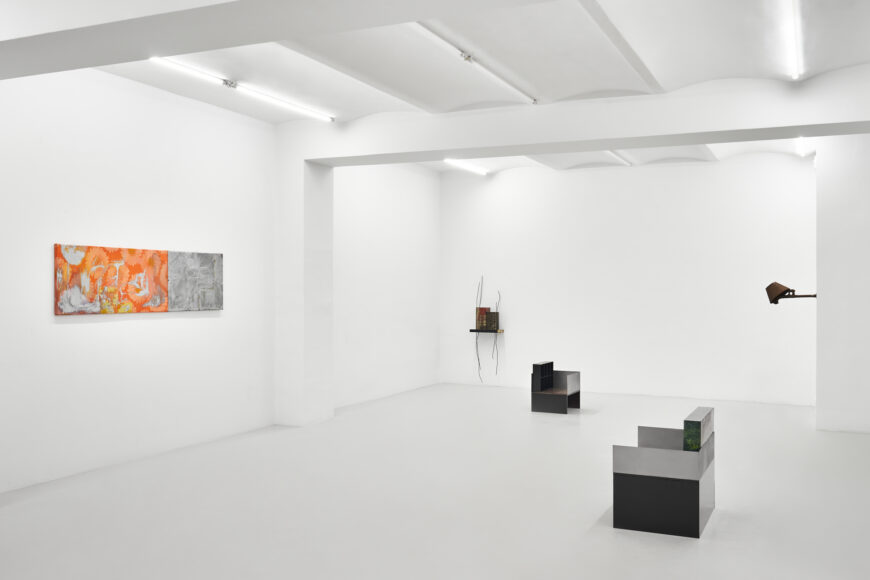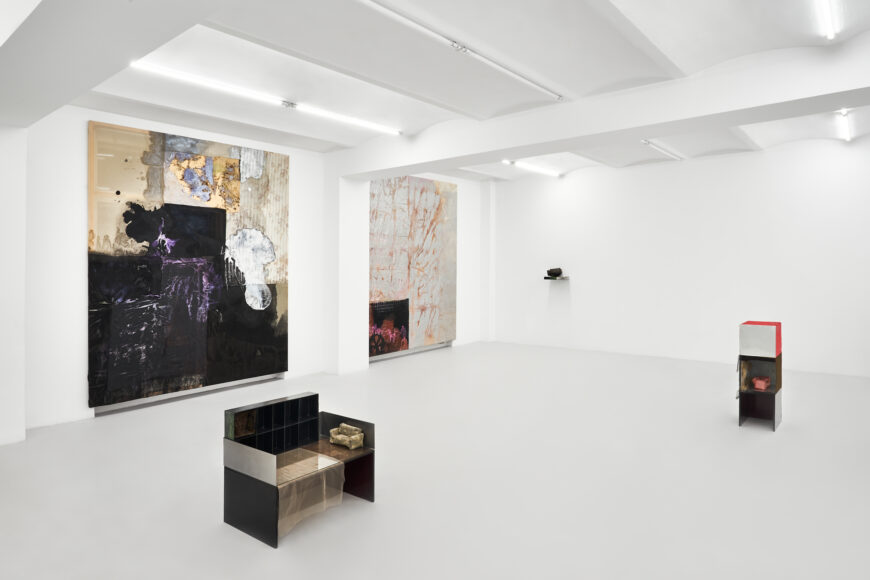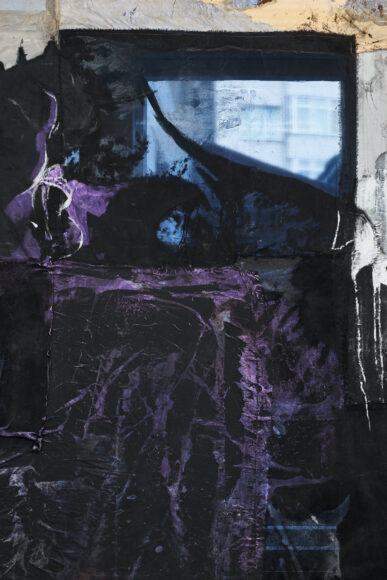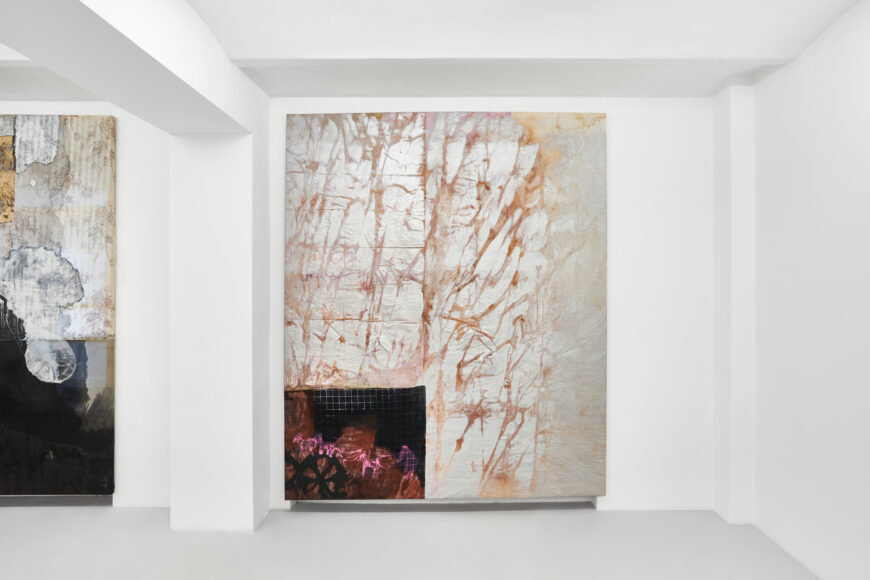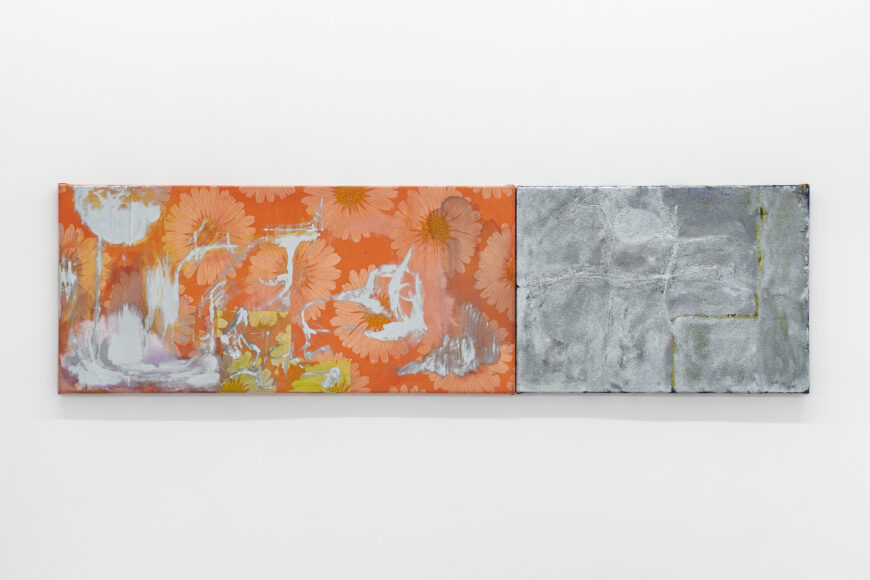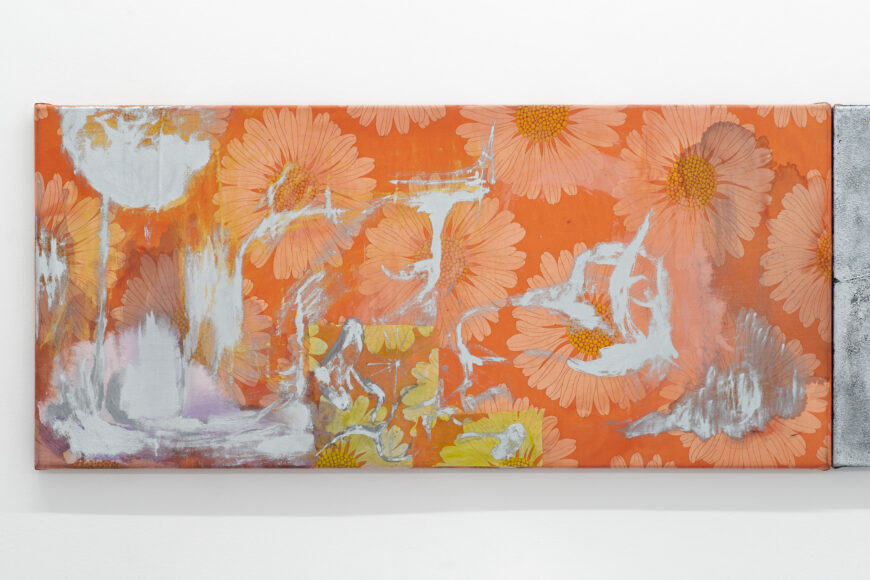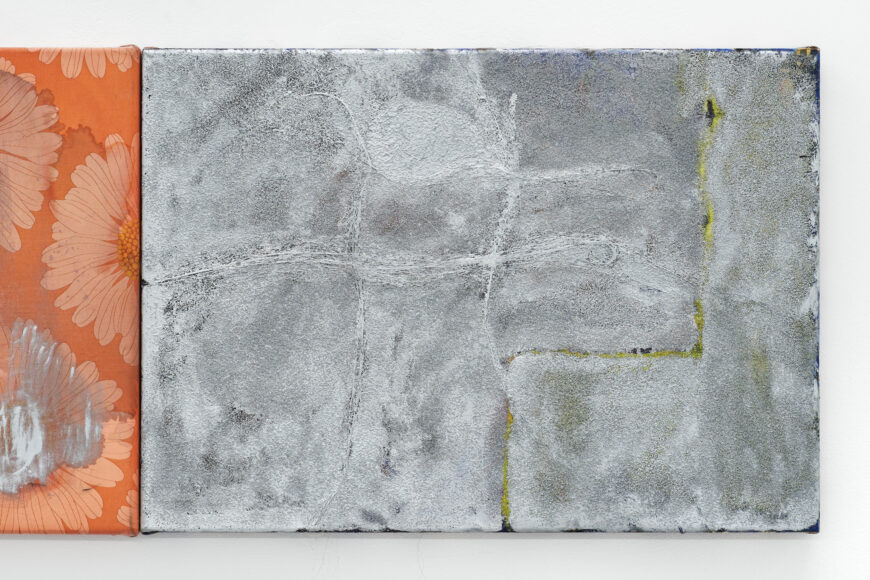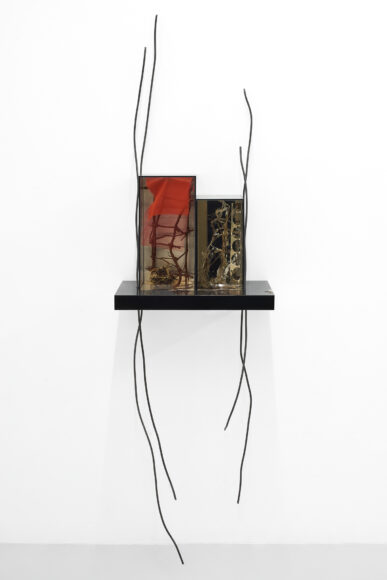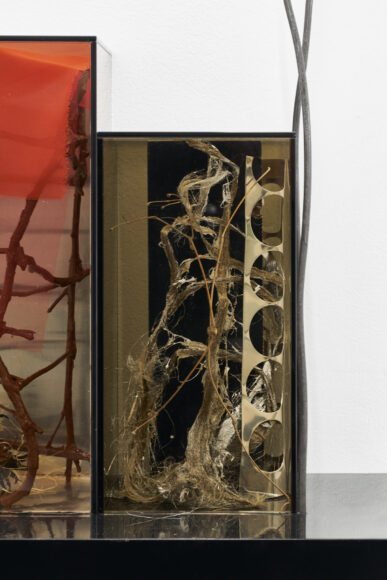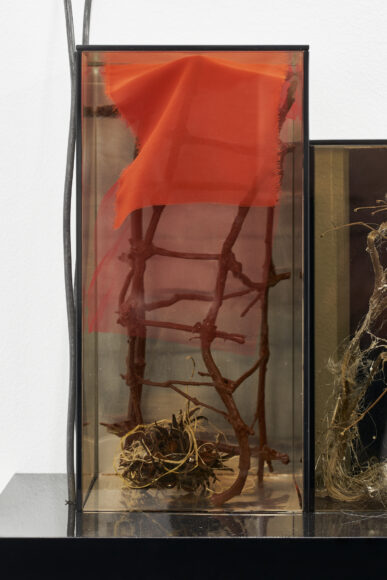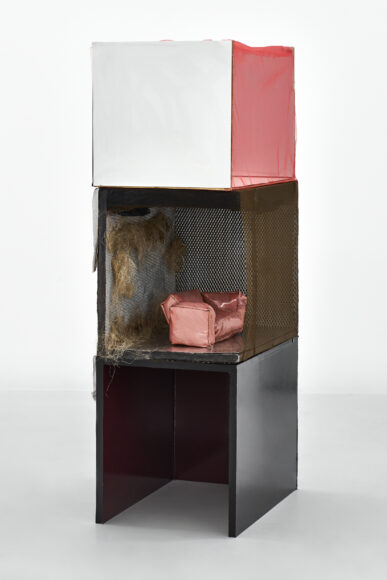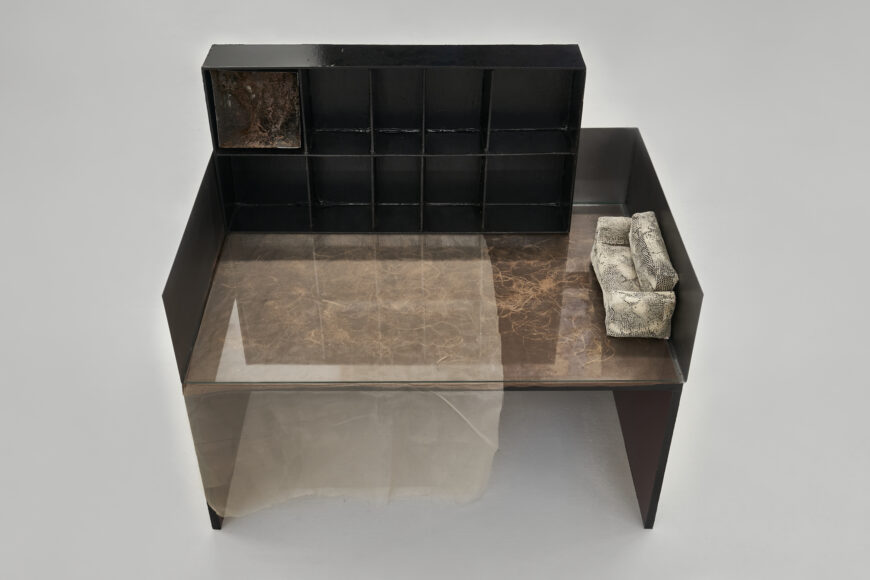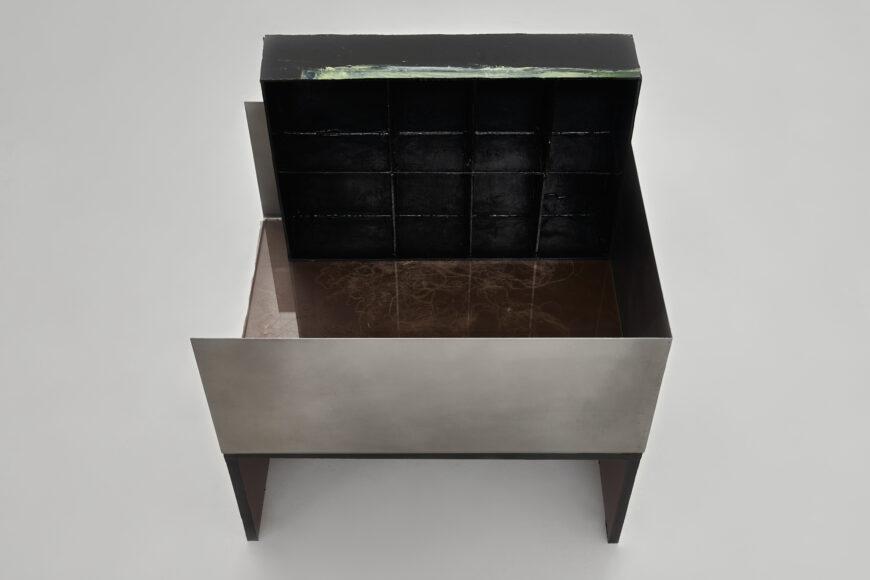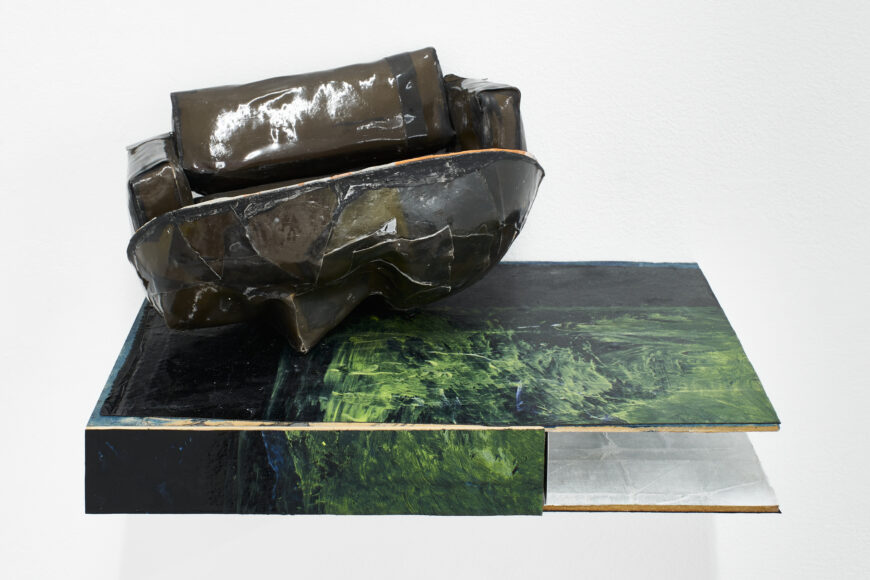Ania BąkThings That Come in Waves 2.7—27.8.2021
The spacetime, to which Anna Bąk invites us, resembles a phantasmal house; an abandoned house, already freed from the human bustle, repairs, cleaning, and the incessant replacement of worn-out objects with new ones. The objects that fill it bear traces of their former functions. The human mind, addicted to classifying and taming unfamiliar forms, even though it knows they are works of art, recognizes here something like a lamp, a toy, the remains of a curtain, furniture… The quiet murmur filling the gallery may bring to mind the humming of a fan or other household appliances. Of course, everything is off here and it is immediately clear that it is an illusion created by art.
But what is illusion and what is reality?
The first attempts to understand the function of objects belong to the consensus reality. According to Arnold Mindell, the founder of process oriented psychology, which at the moment colors my way of seeing things, it is dominated by everyday and material matters, as well as socially accepted logic. In this dimension, humans are autonomous and causal, act intentionally, consciously, and identify with their actions. Cognition and orientation in space and time correspond here to the laws of classical physics. Space has three dimensions and time runs linearly. The world consists of objects with certain physical characteristics: mass, shape, electric charge, position, and speed. These objects are relatively autonomous, and when they interact, they evolve in a deterministic manner.
In this everyday, consensus reality, the consciousness of the observer of reality does not matter, because reality is objective. Elements of the human body and objects have their definite shapes and functions: the head is used for thinking, toys for playing, a chair for sitting, a lamp for lighting, ventilation for cooling the air, a curtain for decoration, and garbage belongs in the garbage can. We make a drink out of kombucha mushrooms, and latex (a.k.a. rubber) is turned into gloves or sexual gadgets – and we don’t think about the dark energy associated with the colonial origins of this material. Physics studies matter and energy, psychology studies the human mind, and art serves to deepen reflection or entertain. In this dimension of the world, we focus on states that provide an illusion of security and permanence: solid state of matter, established ways of knowing and functioning, distinct places such as home, the office, or the city, and finally, life stages and identities (e.g., a student, worker, consumer, youth, old age…).
However, what we do not see, do not know, or are afraid to discover in ourselves and in the world does not disappear and does not stop influencing us. It appears individually and collectively in the unconscious and in the dreamland, where – in Mindell’s terms – external objectivity ceases to apply, and our desires, memories, fantasies, perceptions, and feelings are expressed. What we do not identify with also manifests itself in secondary processes: in what bothers us, what happens outside our will and consciousness.
On the other hand, what we separate in order to understand and tame it more easily turns out to be more complex, dynamic, and strangely intertwined. These relationships are revealed beyond causal links, for example, in synchronicities, which according to Carl Gustav Jung are a hypothetical principle of the all-union of events and mental states. In the dreamland, the laws of classical physics, such as gravity, no longer apply. Spacetime appears to be tensile and fluid. The boundaries between persons and objects blur, objects change scale and function, time loops. Permanent states begin to blur and turn into dynamic, interactive processes.
Because the consensus reality has been privileged for centuries, we encounter an edge on the way to consciously moving to the dreamland: anxiety and attachment to social roles. However, cutting ourselves off from dream energy and unintentional desires causes life (both personal and social) to become flat, depressing, and boring, as well as hollow. It becomes just an illusion, an accepted and often idealized image.
The phantasmal spacetime, designed in the Skala Gallery by Anna Bąk, is a proposal to cross this edge. The artist designs and stimulates it as a sensual experience, which is meant to break us out of the consensus reality. The process of her work resembles an alchemical transmutation: from the analysis and understanding of matter, through its disintegration, to the creation of other matter or the extraction of other qualities from it. As a result, a head can become a thing – a support for a sofa, a lamp can be a carrier of memories, and a curtain – a disturbing stain. Matter begins to disperse and vibrate, revealing its vitality and dynamics and freeing itself from the previous functions and shapes of objects. In some objects, the dominant quality is rust, others absorb the attention with the flash of latex, sheet metal, the porous texture of glass granules or iron filings. The relationship with the senses of the viewers is also established through low-frequency sounds. Emitted from objects resembling furniture (Sounds That Come in Waves), they resonate with bodies in a non-local way, turning them into instruments. The meanings of some things and materials remain in suspension, in a potential state – they have been forgotten or not yet recognized.
As framed by quantum physics, the role of the observer – the artist and the viewer – becomes crucial, because the experienced world is represented here from the inside. Depending on how they are perceived – to paraphrase the title of the exhibition – things can come to us in waves.
In quantum experiments with matter and energy, electrons or light are, using one method of measuring, waves, and, using other research tools, particles. Because we have been trained and coached for centuries to perceive and universalize only one objective dimension of reality, most of us do not know how to draw conclusions from invisible quantum processes. However, both process oriented psychology and quantum physics offer us helpful figures of parallel worlds and superposition. When a measuring device captures a particle, its wave function does not disappear, it exists virtually (in a so-called imaginary way). The same happens when we apply purely utilitarian criteria to everyday objects – their other, unconscious qualities do not cease to exist, they just operate in parallel (unconscious, secondary) worlds. These may be, for example, emotions, energies, or the fantasies associated with them, marginalized biochemical processes (e.g., the process unpleasant to human sensibility, conventionally called decay), or still other material affairs. Superposition, on the other hand, is an assemblage of all possible states (quantum, mental) and parallel worlds – a potential reality. We can approach it without scientific tools, with an accepting openness to the signals coming from the body, our premonitions, and dreams, as well as the movement between different dimensions of reality.
Anna Bąk’s objects are just such assemblages, which – while mystifying – project the experience of matter as a multidimensional, dynamic process.
text: Joanna Sokołowska
—
Ania Bąk (born in 1984) is a graduate of the Academy of Fine Arts in Łódź. In her artistic activity she uses various means of expression: she paints and creates objects, moving images, and sounds. She has participated in numerous exhibitions in Poland and abroad, including Enblanco Gallery and Grimmuseum in Berlin, Spedition Gallery in Bremen, 9/10 Gallery and SKALA Gallery in Poznań, Galeria Czynna and Pracownia Portretu in Łódź, as well as in the festivals Trans Art in Bolzano and the Warsaw Autumn. Her recent exhibitions include Drumming the Night at Pracownia Portretu in Łódź (2019) and Comic Eyes of the Sun, Not Tears [Komiczne oczy słońca, nie łzy] (with Wera Bet) at OS17 in Szczecin (2019). In 2015 she received the scholarship of the President of the City of Łódź for people involved in artistic creation.
Since 2011 she has been working in the Multimedia Studio at the Academy of Fine Arts in Łódź. She lives in Poznań.
